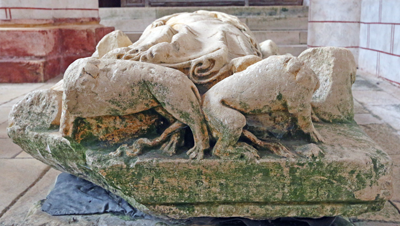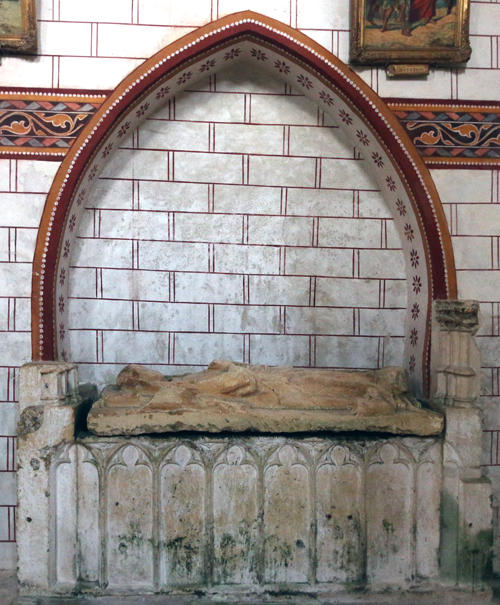 |
Vienne |
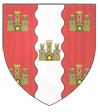 |
||||||||||||||
|
||||||||||||||||
 |
Guesnes |
| There was a double priory here dependent on
the Abbey of Fontevraud, now mostly in a ruinous state. The
monks' church was converted into the parish church of the
village but what remains of the nuns' quarters is now a private
house. The actual church of the latter is now an out-building in
a partly derelict condition. The two effigies lie under arches
at either side of the nave. At some point a substantial wall had
been built across the nave, dividing not only the nave itself
but also the monuments themselves in two. The upper part
of both effigies - the eastern part - has been almost totally
destroyed. Generally not accessible but occasionally open to the public. Park in village nearby. 46°54'57"N, 0°9'45"E |
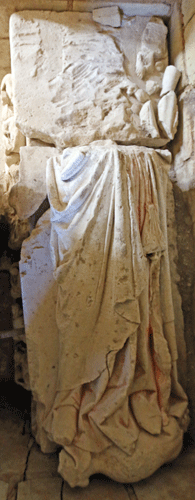 |
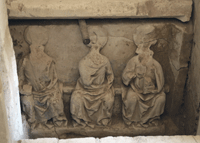 |
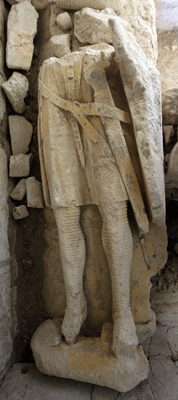 |
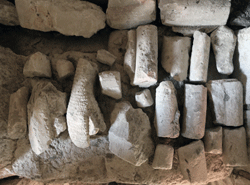 |
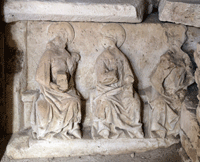 |
Far left: Effigy of a lady. Note the purse
attached to her belt and what looks like an animal (dog)
next to where the head used to be. It looks like a
second has been cut out from the opposite side. The
first is
shown at bottom of the next column and is an unusual as
normally angels support the pillow. Also shown are
figures on what remains of the tomb chest.
Left: Military effigy. Above are shown fragments including a mail gauntlet. |
||
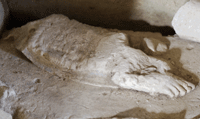 |
 |
Loudon - Church of St Peter du Marche |
 |
| The church is Eglise de St Pierre du
Marche not St Hilaire
de Martray, which is open infrequently. Church open; park in free car park 47˚ 0' 41" N; 0˚ 4' 40" W |
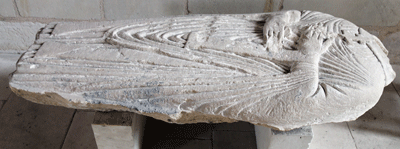 |
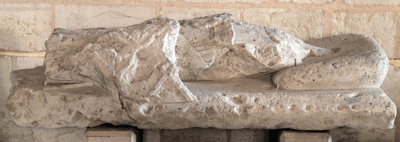 |
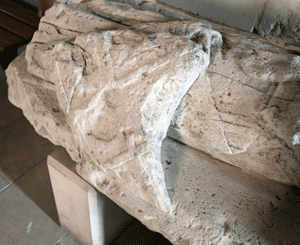 |
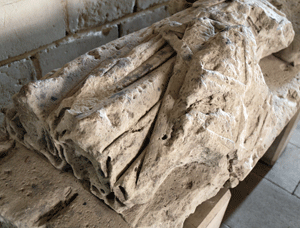 |
| Very damaged effigies of an unknown ecclesiastic | A military effigy of Fretard de Turzay | ||
| Mazarolles |
| Monument to Sir John Chandos, erected in the fourteenth century by the English who then occupied this part of France. It was originally sited on the banks of the River Vienne, where Sir John was mortally wounded on the bridge over the river. It proved in the 19/20th centuries to be an obstruction and was moved to this enclosure in 1905.There is a low wall around the site and large gates, which were open when we visited. |
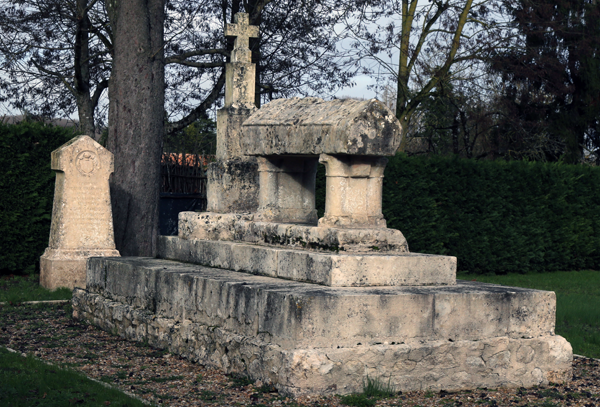 |
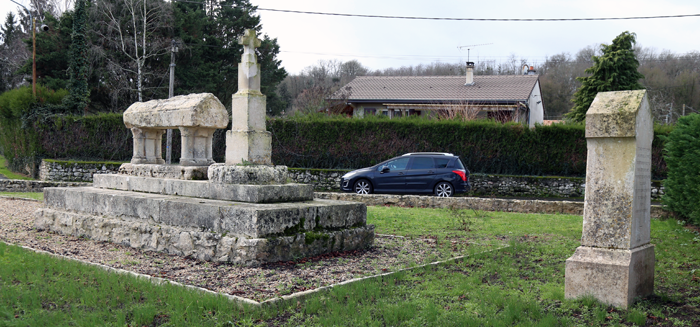 The Sir John Chandos memorial or cenotaph. In some photographs it is difficult to see the relationship of the various parts and this can make the site look like a cemetery: it is not, the various parts being all of the same monument. The cross is part of the main monument of the 14th century. The stela is 20th century and records to monument being moved from its original site. |
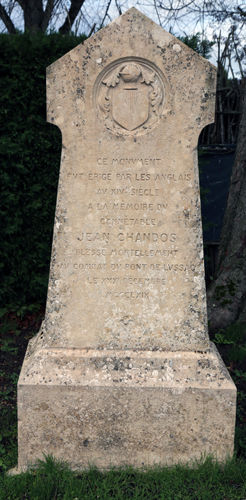 |
.png) |
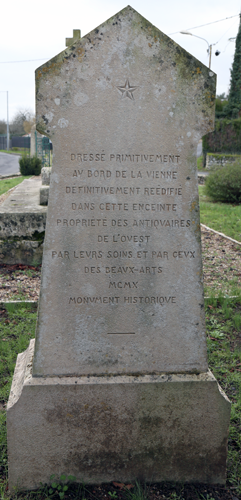 |
Above left: The aspect of the stela facing the monument. The inscription, in French, reads: 'This monument was erected by the English in the 14th century in memory of the constable John Chandos mortally wounded in the Battle of Lussac Bridge on the 31st December 1369' Above centre: Coped top of the monument, much weather worn. I can make out a sword and possible a shield on one face. There is no inscription visible. Above right: The reverse aspect of the stela. The inscription reads: 'Originally erected on the banks of the Vienne, rededicated in this enclosure, property of the Antiquarians of the West, and under their care and that of the Organization of Fine-Arts. 1905. Classified as an Historical Monument |
||
| Sir John Chandos |
Sir John Chandos was a man of relatively humble origin who became a famous commander in the early phases of the Hundred Years' War, serving at Crécy and Poitiers, as well as at Najera in the Black Prince's Spanish intervention. He was eventually appointed Constable of Aquitaine and was the Black Prince's principal military lieutenant in that duchy. In 1369 at Poitou the young Earl of Pembroke refused to serve under him, it being 'unfitting' for an earl - even one with very limited military experience' to serve under a mere knight. As a result their two armies divided. On the last day of December that year Sir John tried to capture a French company as it crossed the bridge over the River Vienne at Lussac, so entering Poitou. The French commander, however found the bridge blocked by the English army of about one hundred and forty men. There was fierce fighting but before the French could break out they were attacked from behind by Sir John who had brought the rest of his troops round to the other bank of the river, so the French were crushed between the two English forces. Casualties were high and many French prisoners were taken. Sir John, like many professional soldiers, never wore a visor and was stabbed in the face. The day was frosty and he had slipped on the long cloak he was wearing. He died the following day at Morthemer were he was buried. |
 |
Morthemer - Notre-Dame |
 |
| The church is open
during normal hours. Access: you may park in the road shown in the photograph on your left. You may then reach the church via the footpath whose entry is shown to the left of the house with the blue notice (for sale) outside; however there is then a steep climb via a number of steps to the church. Alternatively, If you turn left into the road past the house on the extreme right of the photograph you may drive to the seemingly unused back door of the castle where there is a little parking. There is then a foot path with a few steps to the church. Both paths are marked. Well worth a visit. 46° 28.42' N/ 0° 36.62' E |
 |
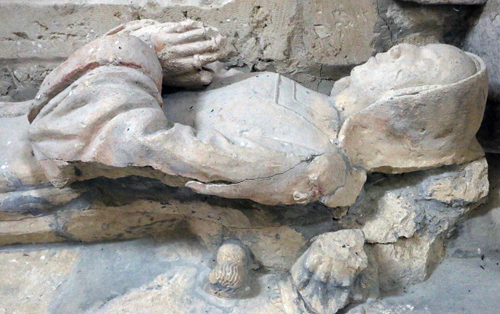 |
|

|
 |
|
| The effigy is of Renée Sanglier.
She born in 1469, the daughter of Joachim, knight
and Lord of Boisrogues, and his wife, Jeanne Bonnet. She
married Louis de Montmorency Laval in 1485 but he died in 1494.
She married for a second time Mathurin Taveau, Baron of
Morthemer. The effigy is now at the west end of the church where
there is also a coffin lid with a sword and a stone coffin
shaped for feet as well as the head below it, although none of
these are related. It is believed that the effigy with that of
her husband lay under an arch in the north wall of the nave, but
also Rennée's effigy has been found in excavations that of her
husband had not. Unfortunately Renées feet rest on a dog (usual but not universal for women) rather than a sanglier, which is French for 'wild boar'! |
 |
Rossay (near Loudun) Prieuré de Bois Rogue |
| This chapel is not usually open to the
public but is used for art exhibitions when it may be visited.
Park outside. 46°59'02"N, 0°08'36"W |
|
 |
|
| Effigy said to be of Gilles Sanglier (c 1500) Inscription in Latin | |
| POITERS |
| Poitiers has a number of medieval churches but very few monuments. An interesting and attractive city to visit with plenty of car parks, some free |
 |
Ancien
Baptistère Saint-Jean Rue Jean Jurès |
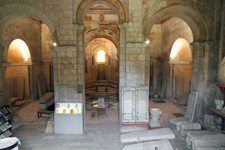 |
Entrance fee: €3.00. Photography allowed. Not open every day and closes for lunch; best to check website This is said to be the oldest Christian building in Western Europe |
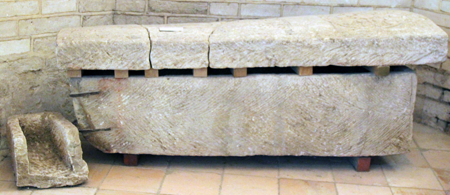 |
 |
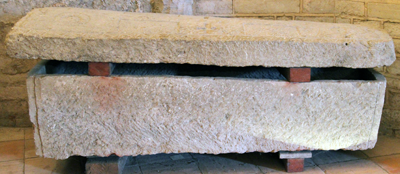 |
 |
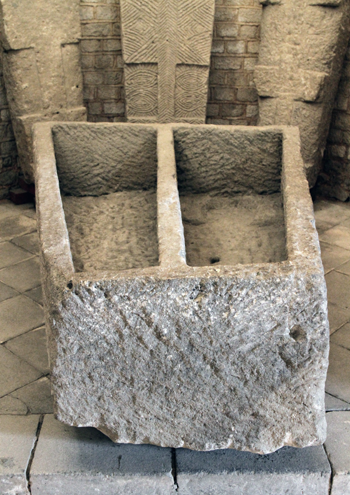 |
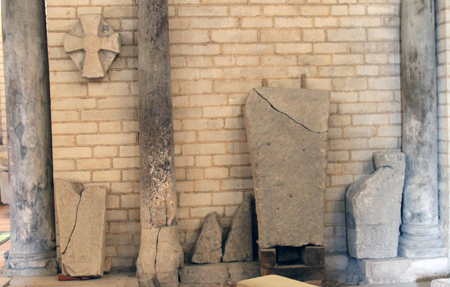 |
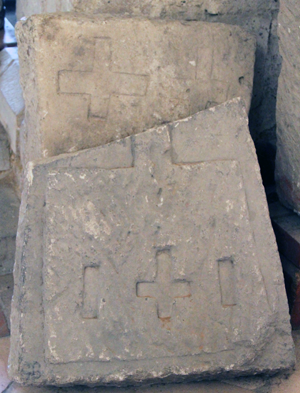 |
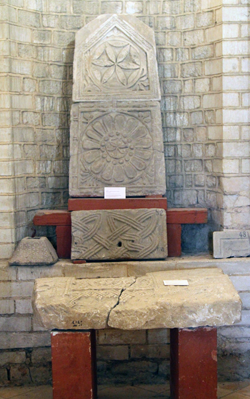 |
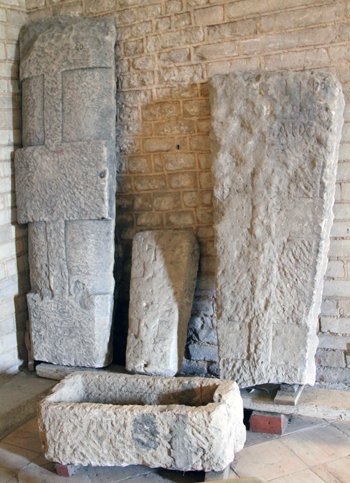 |
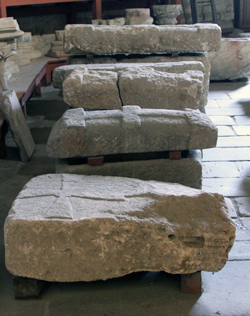 |
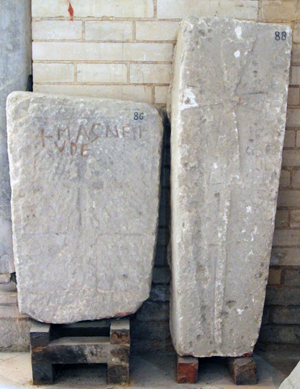 |
 |
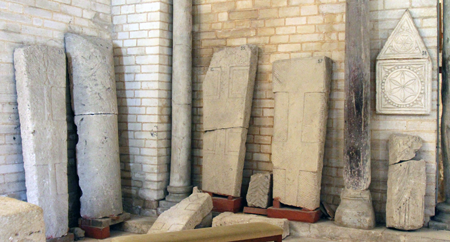 |
 |
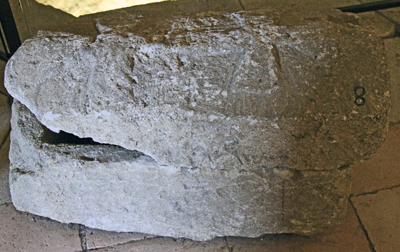 |
 |
 |
 |
The building dates from the 7th century (630-700); it is a rare example of a baptistery as well as of a Merovingian building preserved with its original facades. We now associate baptism with churches but originally the ceremony was carried out in a separate building adjacent to but not connected to the cathedral. This building began life as a baptistery where adults were baptsed by total immersion in a pool set into the ground in the central part of the building. During the Carolingian period baptisms began to be carried out in parish churches so the baptismal pool gradually became irrelevant; the baptistery was converted into the Church of St John the Baptist, the central pool being filled in, to be replaced by a central altar. The baptistery is not only now a museum of Merovingian stone but there are also very fine wall painting beginning from the end of the 11th century. The State bought the building in 1834 and handed it over to the local Society of Antiquaries in1836, who still manage it. The collection of sarcophagi is the work of Camille de la Croix and come from towns in Vienne including Poitiers itself, and date from the time of the baptistery (5th - 10th centuries). There are a number of designs on the lid which may be seen in the photographs and some lettering |
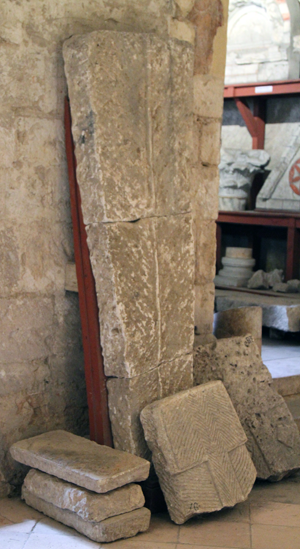 |
 |
Poiters Cathedral |
 |
| Just across from the
Baptistery. As usual in France, no charge, no restrictions on
photography, no refectory and no shop. The diocese of Poitiers was elevated to an archdiocese in 2002 so the monuments below are correctly to 19th century bishops |
 |
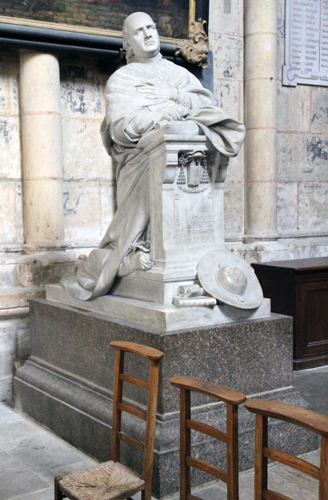 |
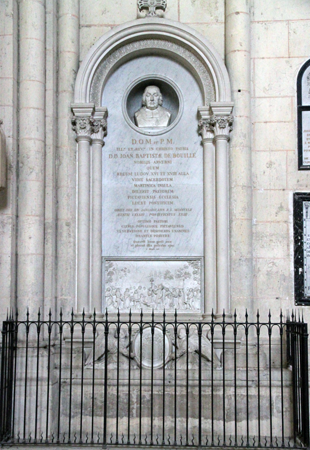 |
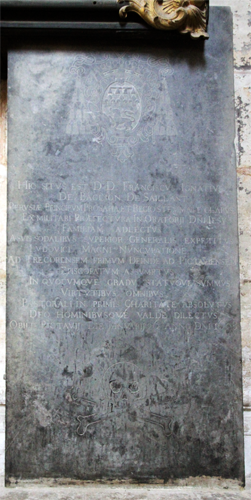 |
| Monuments of
Bishops of Poiters Left top: Joseph-Aimé Guitton (1849) Left bottom: Jean-Baptiste-Luc Bailly (1804) Top left: Cardinal Louis-François-Désiré-Edouard Pie (1880) Curiously his name does not appear on the monument but that of the sculptor is prominantly displayed on the left side of the base. Top centre: Jean-Baptiste de Bouillé (1842) Top right: François-Ignace de Baglion de Saillant (1698) This looks like the tomb stone of the late 17th century bishop now set against the wall with part of a heavy picture frame covering the upper part |
|||
| Ancienne Abbatiale Saint-Jean de
Montierneuf 29 Place Montierneuf |
| Built at the end of the 11th century by Guy-Geoffrey-William, 'The Eagle' 7th Duke of Aquitaine It was his burial place but all monuments and sites of interment were lost at the Revolution |
| At the moment (2019) the church is undergoing major construction work and although you may enter most of the building. The monument to William, 7th Duke of Aquitaine - a cenotaph built in the 19th century - is covered by a wooden cage for protection and cannot be seen. |
| ⁻¹ It appears his birth name was Guy-Geoffrey, the William being added when he became Duke of Aquitaine; he was already Duke of Gascony. The inheritance of the Duchies of Aquitaine, Gascony and County of Poitou is complicated as they do not necessarily follow each other so the numbers do not always correspond. Incidentally women had exceptionally good rights in this part of France during this period which they were not to gain again until the 20th century. Although geographically part of what we call France, this region was virtually independent. |
 |
Chauvigny - Collegiate Church of St Peter |
 |
| Note this is not the church in the town
centre (Our Lady of Chauvigny) but the church in the 'Cité
Medievale' on the hill near the ruined castle. There are eateries and toilets in this enclave, as well as fine views. There is limited free visitors' parking a short distance just outside the medieval city; otherwise there is plenty of free car parks in the town but the walk up the hill to the 'city' a steep one. 46° 3.22' N/0° 38.36'E |
 |
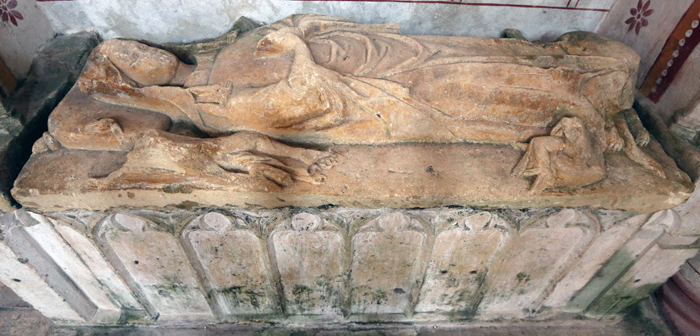 |
|
|
|||||||

